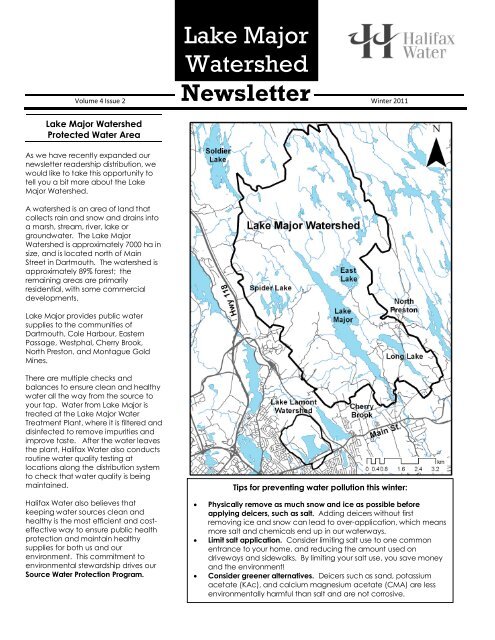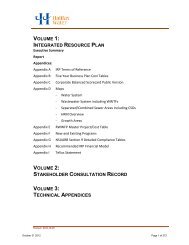Newsletter Lake Major Watershed - Halifax Regional Municipality
Newsletter Lake Major Watershed - Halifax Regional Municipality
Newsletter Lake Major Watershed - Halifax Regional Municipality
You also want an ePaper? Increase the reach of your titles
YUMPU automatically turns print PDFs into web optimized ePapers that Google loves.
<strong>Lake</strong> <strong>Major</strong><br />
<strong>Watershed</strong><br />
<strong>Newsletter</strong><br />
Volume 4 Issue 2 Winter 2011<br />
<strong>Lake</strong> <strong>Major</strong> <strong>Watershed</strong><br />
Protected Water Area<br />
As we have recently expanded our<br />
newsletter readership distribution, we<br />
would like to take this opportunity to<br />
tell you a bit more about the <strong>Lake</strong><br />
<strong>Major</strong> <strong>Watershed</strong>.<br />
A watershed is an area of land that<br />
collects rain and snow and drains into<br />
a marsh, stream, river, lake or<br />
groundwater. The <strong>Lake</strong> <strong>Major</strong><br />
<strong>Watershed</strong> is approximately 7000 ha in<br />
size, and is located north of Main<br />
Street in Dartmouth. The watershed is<br />
approximately 89% forest; the<br />
remaining areas are primarily<br />
residential, with some commercial<br />
developments.<br />
<strong>Lake</strong> <strong>Major</strong> provides public water<br />
supplies to the communities of<br />
Dartmouth, Cole Harbour, Eastern<br />
Passage, Westphal, Cherry Brook,<br />
North Preston, and Montague Gold<br />
Mines.<br />
There are multiple checks and<br />
balances to ensure clean and healthy<br />
water all the way from the source to<br />
your tap. Water from <strong>Lake</strong> <strong>Major</strong> is<br />
treated at the <strong>Lake</strong> <strong>Major</strong> Water<br />
Treatment Plant, where it is filtered and<br />
disinfected to remove impurities and<br />
improve taste. After the water leaves<br />
the plant, <strong>Halifax</strong> Water also conducts<br />
routine water quality testing at<br />
locations along the distribution system<br />
to check that water quality is being<br />
maintained.<br />
<strong>Halifax</strong> Water also believes that<br />
keeping water sources clean and<br />
healthy is the most efficient and costeffective<br />
way to ensure public health<br />
protection and maintain healthy<br />
supplies for both us and our<br />
environment. This commitment to<br />
environmental stewardship drives our<br />
Source Water Protection Program.<br />
Tips for preventing water pollution this winter:<br />
· Physically remove as much snow and ice as possible before<br />
applying deicers, such as salt. Adding deicers without first<br />
removing ice and snow can lead to overapplication, which means<br />
more salt and chemicals end up in our waterways.<br />
· Limit salt application. Consider limiting salt use to one common<br />
entrance to your home, and reducing the amount used on<br />
driveways and sidewalks. By limiting your salt use, you save money<br />
and the environment!<br />
· Consider greener alternatives. Deicers such as sand, potassium<br />
acetate (KAc), and calcium magnesium acetate (CMA) are less<br />
environmentally harmful than salt and are not corrosive.
Source Water Protection<br />
Source waters are the untreated<br />
water sources what we use for public<br />
water supplies. All the water within the<br />
<strong>Lake</strong> <strong>Major</strong> <strong>Watershed</strong> is considered to<br />
be source water (i.e., lakes, rivers,<br />
wetlands, and groundwater).<br />
Our goal for source water protection is<br />
to maintain, or improve, the quality of<br />
drinking water resources before it<br />
reaches the treatment plant.<br />
Protecting water at the source helps<br />
to prevent contaminants from entering<br />
the drinking water system.<br />
In general, <strong>Halifax</strong> Water’s protection<br />
program for <strong>Lake</strong> <strong>Major</strong> includes:<br />
· <strong>Lake</strong> <strong>Major</strong> <strong>Watershed</strong> Advisory<br />
Board<br />
· Regulations for Environmental<br />
Protection<br />
· Purchasing <strong>Watershed</strong> Lands<br />
· Sound Forest and Land<br />
Management<br />
· Source Water Area Monitoring<br />
· Public Awareness and Education<br />
· Research Projects and Other<br />
Initiatives<br />
In the previous <strong>Lake</strong> <strong>Major</strong> <strong>Watershed</strong><br />
newsletter, we highlighted our<br />
watershed monitoring program, as<br />
well as some of our public awareness<br />
and education projects.<br />
From a regulation standpoint, the <strong>Lake</strong><br />
<strong>Major</strong> <strong>Watershed</strong> was designated as a<br />
Protected Water Area in 1986 by the<br />
Province of Nova Scotia. The<br />
designation regulates activities such as<br />
fire, vehicles and water vessels, fishing<br />
and hunting, construction and<br />
development, chemical application,<br />
among issues that could affect water<br />
quality. The full list of regulations can<br />
be found on the internet:<br />
www.gov.ns.ca/just/regulations/regs/<br />
envpwlmr.htm<br />
Maintaining healthy forests in the <strong>Lake</strong><br />
<strong>Major</strong> <strong>Watershed</strong> into the future is vital<br />
for conserving quality water supplies.<br />
A research project in collaboration<br />
with Dalhousie University has been<br />
recently completed that contributes<br />
to this goal. James Steenberg, a<br />
Master of Environmental Studies<br />
student in the School of Resource and<br />
Environmental Studies, investigated<br />
how potential effects of climate<br />
change may alter the <strong>Lake</strong> <strong>Major</strong><br />
<strong>Watershed</strong> forested areas.<br />
James used computer modeling<br />
techniques to simulate how our native<br />
tree species would respond to<br />
change, and projected how various<br />
forestry management techniques<br />
could be used to maintain a healthy<br />
watershed forest ecosystem.<br />
More information on the <strong>Lake</strong> <strong>Major</strong><br />
<strong>Watershed</strong> and <strong>Halifax</strong> Water’s Source<br />
Water Protection Program can be<br />
found on our website:<br />
www.halifaxwater.ca<br />
<strong>Lake</strong> <strong>Major</strong> <strong>Watershed</strong><br />
Community News<br />
Forestry Activities – As the hurricane<br />
cleanup efforts were completed in<br />
2009, there were no forestry<br />
management activities planned for<br />
2010.<br />
Website Update – Watch for <strong>Halifax</strong><br />
Water’s new Source Water Protection<br />
website in winter 2011. The site will<br />
feature up to date information on the<br />
<strong>Lake</strong> <strong>Major</strong> <strong>Watershed</strong> and how we<br />
can protect our water supplies.<br />
Profile of Reid Campbell<br />
Reid Campbell is Director of Water<br />
Services with <strong>Halifax</strong> Water. In this role<br />
he is responsible the operation of all<br />
aspects of the municipal water<br />
supplies serving <strong>Halifax</strong> <strong>Regional</strong><br />
<strong>Municipality</strong>.<br />
This includes over 100 employees<br />
working in water treatment plants,<br />
water quality management,<br />
distribution system operation and<br />
maintenance and technical services,<br />
which is the group that looks after<br />
computerized controls and<br />
communications systems that allows its<br />
facilities to work. Water Services also<br />
includes Source Water Protection<br />
which includes the <strong>Lake</strong> <strong>Major</strong><br />
<strong>Watershed</strong> Advisory Board.<br />
Reid joined <strong>Halifax</strong> Water as Planning<br />
Engineer in 1998. In 2001, he became<br />
Manager of Plant Operations and in<br />
August 2007, with the merger with<br />
HRM’s wastewater system he became<br />
Director of Water Services.<br />
Prior to joining <strong>Halifax</strong> Water, Reid<br />
worked for a large consulting<br />
engineering company in Toronto for six<br />
years, where he was involved in the<br />
design of water treatment plants and<br />
pumping stations. He then worked for<br />
a smaller consulting company in<br />
<strong>Halifax</strong> for four years, and while in that<br />
role had the opportunity to work on<br />
the <strong>Lake</strong> <strong>Major</strong> Water Treatment Plant<br />
project. Reid has been involved with<br />
the current treatment plant since the<br />
early days of its design and<br />
construction.<br />
Reid says he finds his participation in<br />
the LMWSAB very rewarding. “All of<br />
the community members of the Board<br />
have a long history of community<br />
involvement and volunteerism and it is<br />
very rewarding to work with people<br />
who are putting such effort into the<br />
betterment of their communities.”<br />
Reid lists the completion of the <strong>Lake</strong><br />
<strong>Major</strong> plant, successful recovery of the<br />
Hurricane Juan forest damage, the first<br />
phase of the Preston trail system, and<br />
the establishment of the Arnold<br />
Johnson scholarship as highlights of his<br />
time working with the watershed<br />
communities.<br />
How to Contact Us:<br />
The <strong>Lake</strong> <strong>Major</strong> <strong>Watershed</strong> <strong>Newsletter</strong> is a<br />
publication of <strong>Halifax</strong> Water. Visit our<br />
website at www.halifaxwater.ca, contact<br />
Customer Service at 4904820, email us at<br />
Cust_Inq@halifaxwater.ca, fax us at 490<br />
4749, or write to us at P.O. Box 8388 RPO<br />
CSC, <strong>Halifax</strong>, Nova Scotia, B3K 5M1<br />
24 hr Emergency Phone:<br />
(902) 4906940

















